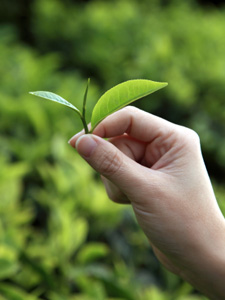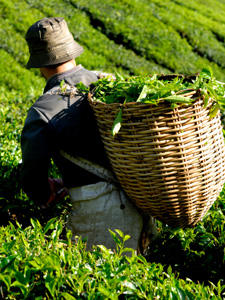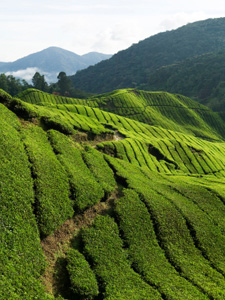What is Tea?



Welcome to the Beginners course of TeaClass. This training program is designed to give you the foundation of information that will allow you to begin your journey through the world of tea. In this first lesson, we will define tea and examine the most common varieties.
What is tea?
That's a good question! Tea is the second most consumed drink in the world, surpassed only by water. An often-surprising fact to tea novices is that all teas (Black, Green, Oolong, White, and Pu'erh) come from the same plant. The scientific name of this versatile plant is Camellia sinensis (it's actually related to the lovely camellia flowers seen in botanical gardens and landscapes). Camellia sinensis is a sub-tropical, evergreen plant native to Asia but is now grown around the world. The tea plant grows best in loose, deep soil, at high altitudes, and in sub-tropical climates. So, in short, "tea" is anything derived from the Camellia sinensis plant. Anything else, while sometimes called "tea", is more accurately referred to as an herbal tea or tisane. Tisanes include chamomile, rooibos and fruit teas. We'll learn about those in a minute.
How is it grown?
The tea plant, which grows naturally in the wild throughout much of Asia, is cultivated in a variety of settings from small family gardens to giant estates covering thousands of acres. The best tea is usually grown at higher elevations, and often, on steep slopes. The terrain requires these premium teas to be hand-plucked, and it takes around 2,000 tiny leaves to make just one pound of finished tea. If that sounds crazy, keep in mind these methods have been around for several millennia. Many of the teas produced for large scale commercial production are grown on flat, lowland areas to allow for machine harvesting. However, it should be noted that some of the finest, hand-plucked teas in the world come from flat fields and lower altitude. So, how the tea is grown is just one of many factors to be considered.
Teas which are processed in the traditional fashion are called Orthodox teas. Orthodox teas generally contain only the top two tender leaves and an unopened leaf bud, which are plucked carefully by hand and then processed using five basic steps, creating the thousands of varieties of tea we know and love today (note: While tea plants do have small flowers, the "buds" tea people refer to are the young, unopened leaves, not flowers). Most Orthodox tea production these days involves a unique combination of age-old methods, such as bamboo trays, to allow the leaves to wither on, and modern, innovative machinery, like leaf rollers carefully calibrated to mimic motions originally done by hand. A true art form, the tea is handled by artisans with often generations of training from the moment of plucking to when the tea is finished. For some teas, one batch can take several days of work.
The other way of making tea is the Unorthodox method, of which the most common type is CTC (crush-tear-curl). This much faster style of production was specifically created for black tea. These teas may or may not be plucked by hand. For commercial production, large machine harvesters are used to "mow" the top of the bushes to get the new leaves. CTC production uses a leaf shredder which macerates the leaves (crushing, tearing, and curling them, hence the name) into fine pieces. They are then rolled into little balls. The result looks quite a bit like Grape Nuts cereal, actually. These teas will brew very quickly and produce and a bold, powerful cup of tea. Crush-tear-curl is usually used primarily in the tea bag industry, as well as in India to create Masala Chai blends (due to their strength and color).
What is in tea?
The three primary components of brewed tea (also called the "liquor") are:
1. Essential Oils - these provide tea's delicious aromas and flavors.
2. Polyphenols - these provide the "briskness" or astringency in the mouth and are the components that also carry most of the health benefits of tea.
3. Caffeine - found naturally in coffee, chocolate, tea and Yerba Mate, caffeine provides tea's natural energy boost.
How the leaves are processed will determine their final classification as black, green, etc. We'll discuss these styles of tea in the next lesson.
Although tea is one of the most enjoyed beverages worldwide, its culture can be very "local." For example, most tea drinkers in Darjeeling, India have never had (or even heard of) a Taiwanese Pouchong. In China, most people do not drink black tea. The centuries-old Japanese tea ceremony uses powdered, rare Matcha tea, which most folks in black tea-loving Sri Lanka have never tasted. Tea is a truly special, uniting thing, especially when you imagine how so many tea-drinking cultures developed all on their own. America's own newly found tea culture is unique because we actually enjoy all types of tea (white, green, oolong, black and pu'erh). No other country can claim that distinction. The amount of knowledge to be shared and tea to be enjoyed is tremendous. TeaClass seeks to help in this process by providing accurate and insightful tea knowledge.
 teaclass
teaclass
